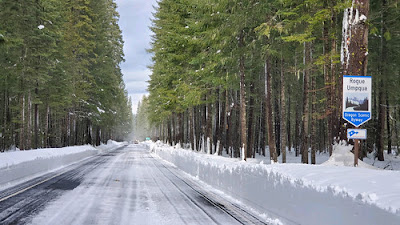Continue to Stand in the Gap: Jackson County
Therefore
with joy shall ye draw water out of the wells of salvation. Isaiah 12:3
OR 230 at Jackson County line
Jackson
County, just to the east of Josephine County and also bordered by California to
the south, is the last county in the South West Region before we move on to the
South Central counties. We have mentioned some of the early history here.
Jackson
County was established in 1852 and has a Board of Commissioners with three
positions. The Board comprises Dave Dotterrer, Colleen Roberts, and Rick
Dyer. Currently, there is a campaign in effect to change the Board of
Commissioners since there have been no changes since the Board was implemented
in 1853. Three petitions are being circulated that need 10,500 signatures each
to be put on the ballot in 2024. So far, the three each have about 7,000
signatures. One petition is to make the commissioners non-partisan; the second
is to increase the number of commissioners; the third is to decrease their pay.
The citizens group behind this move is “Jackson County for All.”
The County
Sheriff is Nathan Sickler. The Sheriff’s Office has worked hard to get
their jail staffing needs up to speed, with dozens of positions filled over the
past two years. Measure 110 is the source of added stress for Oregon law
enforcement, and they are hopeful new proposed legislation in the 2024 short
session of the legislature will address those issues.
 |
| Jackson County, Oregon |
In an
earlier post, we mentioned the Preachers Train, a wagon train that made its way
to southern Oregon via the Applegate Trail and brought the pioneers that made
up the early settlements of the Talent-Phoenix area of Jackson County. The
Preachers Train was so-called due to the high number of ministers who emigrated
from the mid-west in that group. Official records, diaries, and letters all
help piece together who came on the wagon trains of 1853, but with some gaps. There
was more than one wagon train rolling into Jackson County in 1853, especially
into the area around Jacksonville which would be the county seat for several
years until the building of the railroad made Medford the better choice.
Robert Livingston Casebeer, descendent of several pioneers who came over the Oregon Trail
in those early days, and the President of the Board for the Talent Historical
Society, compiled a list of those known to have been on the Preachers Train,
although there may have been more. His list includes William Royal and his sons
Thomas Fletcher Royal and J. H. B. Royal, all Methodist ministers. The Reverend
Stephen Phelps Taylor was another Methodist minister on the train and is known
for establishing the first church in Phoenix, Oregon. St. Andrews Methodist Church was begun in
Jacksonville in 1853 – 54 by two Preachers Train pioneers, Joseph Smith, and the above-mentioned Thomas Fletcher Royal. The Jacksonville church is one of the oldest in the
state.
The father of the Royal clan, William, is said to have been responsible for insisting they not travel on the
Sabbath Day on their trip along the Oregon Trail. Many in their company pushed
on to reach Oregon, but some, at least, followed Rev. Royal’s example and
rested. They found they usually caught up to the company by Tuesday and
continued with them until stopping to rest the next Sunday. In the end, the
Royals reached Jacksonville on August 31, 1853, and the others arrived ten to
fourteen days later, despite not taking Sundays off.
The
Reverend John Stern is another minister traveling on the Preachers Train. He
was a Baptist minister. At 76 years old, he came to Oregon with his extended
family. The common wisdom was that no one over 45 should attempt the long,
arduous journey, but Reverent Stern not only completed the trip, but he
continued to live, work, and minister in Oregon for many years, dying at the
age of 92.
While not
ministers, other notable members on this wagon train include John Beeson and
his wife Ann and son Welborn. They joined the train at the Platte River in May
of 1853 and traveled on to Jackson County with the company. He was noted for his opposition to the treatment of the Native
Americans, to the extent that his life was threatened, necessitating his
leaving the area and living in New York until after the Civil War. Other
accounts indicate he had the ear of President Lincoln, who intended to investigate
the injustices to the Native Americans after the war.
Finally, Mr. Casebeer’s relative, Martin Burt,
was with the group along with his wife, Abigail, and seven daughters and three
sons. He also was not a minister, but earlier in the 1800’s had tried to settle
in Missouri only to leave because his outspoken anti-slavery views put him in
danger. They lived in several places in the Midwest until joining the 1853
wagon train to Oregon.
They were
remarkable people, those early pioneers. The groups that settled in Jackson
County had great strength and deeply held beliefs and values.



Comments
Post a Comment